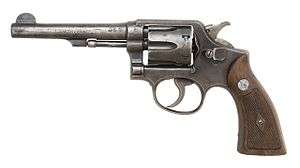Smith & Wesson Ladysmith
| Smith & Wesson Ladysmith | |
|---|---|
| Type | Revolver or pistol |
| Place of origin |
|
| Service history | |
| In service | 1900s–1986 |
| Used by | FBI |
| Production history | |
| Manufacturer | Smith & Wesson |
| Variants |
Model 631LS Model 36LS Model 60LS Model 65LS Model 642LS Model 3913LS |
| Specifications | |
| Barrel length | 2 in (51 mm) to 3.5 in (89 mm) |
|
| |
| Cartridge |
.22 Long .32 H&R Magnum .38 Special .357 Magnum 9mm Parabellum |
| Action |
Double Action Revolver Semi-auto Pistol |
| Feed system |
5-round cylinder (.38 revolver) 6-round cylinder (.32 revolver) 8-round magazine (9mm pistol) |
The S&W Ladysmith and LadySmith are a series of handguns manufactured by Smith & Wesson starting early in the 20th century. Early models, branded Ladysmith, were chambered in .22 Long Rifle Starting in the 1980s, under the slightly modified LadySmith moniker, S&W manufactured several short-barreled revolvers and semi-automatic pistols in .32 H&R Magnum (S&W Model 631LS), .38 Special (S&W Models 36LS and 642LS), .357 Magnum (S&W Model 60LS and S&W Model 65LS) and 9mm Parabellum (S&W Model 3913LS).
History
Smith & Wesson has produced firearms over the years in several standard frame sizes. M-frame "refers to the small early Ladysmith frame".[1] Later LadySmith small revolvers were made on the somewhat larger J-frame, the standard S&W small-frame revolver.
The tiny M-frame .22" hand-ejector Ladysmith revolver was produced from 1902 through 1921, and later diminutive revolvers were termed LadySmith, capitalizing the "S".[1]
During the 1980s, prior to the 1986 FBI Miami shootout, the Federal Bureau of Investigation adopted a revolver very similar to the Model 65 Ladysmith, but without the moniker.
Notable models
- Smith & Wesson Model 60 LadySmith: known as the "Chief's Special LadySmith"; J-frame, .38 cal., 5-shot revolver[2]
- Smith & Wesson Model 65 LadySmith: .357 Magnum, medium frame, 6-shot revolver[2]
- Smith & Wesson Model 3913LS Lady Smith: 9mm, compact frame, 8+1 pistol
Miscellaneous
The LadySmith version of Smith's model 3913 is referred to as the 3913LS. It has a stainless steel slide with an aluminum alloy frame. The 3913LS had a different look to the slide and frame. It is chambered for 9mm only. It has a 3.5 inch barrel and the magazine holds eight rounds.[1] It is one of their third generation semi-automatic pistols that S&W refers to as a "traditional double action". This refers to a mode of operation wherein the first pull of the trigger is longer and heavier, and causes the hammer to rise from its resting position and then fall to strike the firing pin and fire the cartridge in the chamber. After the pistol fires that first time, the pistol is in what is called "single action", wherein the hammer stays cocked and subsequent trigger pulls are much shorter and lighter. The safety/decock lever on the side of the slide can be lowered which will (a) safely drop the cocked hammer, and (b) prevent the pistol from firing by disconnecting the trigger and by rotating a block between the hammer and firing pin. It is the firing pin block that makes dropping the hammer with the decocker safe, albeit somewhat unnerving. The original 3913 has been popular with law enforcement officers that need to carry their primary sidearm concealed. The Lady Smith is very flat because it has a single-stack magazine and only a single thumb safety on the left side compared to the two-sided ambidextrous safety on the 3913NL.[1]
As of 2013, the only models still in production are the 60LS (currently chambered in .357 Magnum, which is different from the original "Chief's Special LadySmith" variant with the same model number) and the 642LS (chambered in .38 Special +P).
